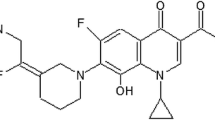Abstract
The fluoroquinolones have been shown to be active in vitro against many mycobacterial species, including most strains of Mycobacterium tuberculosis complex and M. fortuitum, and some strains of M. kansasii, M. aviumintracellulare (MAI) complex and M. leprae. Ciprofloxacin, ofloxacin and sparfloxacin are the best studied of these agents to date, and are among the most active of this group against M. tuberculosis and other mycobacteria. Treatment of patients with multidrug-resistant pulmonary tuberculosis using ofloxacin has resulted in the selection of quinolone-resistant mutants in a few patients. Many strains of MAI, however, are resistant to fluoroquinolones, and structure-activity relationships and DNA gyrase studies have been undertaken to identify the moieties associated with activity and the lack thereof. The genetic and molecular basis of quinolone resistance in mycobacteria has revealed both the recent progress made in these areas and the limitations of the quinolones against this genus. Considerable progress will need to be made in resolving these issues in order for the quinolones to become clinically useful antimycobacterial agents.
Similar content being viewed by others
References
Gillespie SH, Kennedy N. Fluoroquinolones: a new treatment for tuberculosis? Int J Tuberc Lung Dis 1998; 2: 265–71
American Thoracic Society. Diagnosis and treatment of disease caused by nontuberculous mycobacteria. This official statement of the American Thoracic Society was approved by the Board of Directors, March 1997. Am J Respir Crit Care Med 1997; 156: S1–25
Faris MA, Raasch RH, Hopfer RL, et al. Treatment and prophylaxis of disseminated Mycobacterium avium complex in HIV-infected individuals. Ann Pharmacother 1998; 32: 564–73
Yew WW, Piddock LJ, Li MS, et al. In-vitro activity of quinolones and macrolides against mycobacteria. J Antimicrob Chemother 1994; 34: 343–51
Saito H, Sato K, Tomioka H, et al. In vitro antimycobacterial activity of a new quinolone, levofloxacin (DR-3355). Tuber Lung Dis 1995; 76: 377–80
Hoffner SE, Gezelius L, Olsson-Liljequist B. In-vitro activity of fluorinated quinolones and macrolides against drug-resistant Mycobacterium tuberculosis. J Antimicrob Chemother 1997; 40: 885–8
Ji B, Lounis N, Maslo C, et al. In vitro and in vivo activities of moxifloxacin and clinafloxacin against Mycobacterium tuberculosis. Antimicrob Agents Chemother 1998; 42: 2066–9
Saito H, Tomioka H, Sato K, et al. In vitro and in vivo antimycobacterial activities of a new quinolone, DU-6859a. Antimicrob Agents Chemother 1994; 38: 2877–82
Venkataprasad N, Jacobs MR, Johnson JL, et al. Activity of new quinolones against intracellular Mycobacterium avium in human monocytes. J Antimicrob Chemother 1997; 40: 841–5
Sbarbaro JA, Iseman MD, Crowle AJ. Combined effect of pyrazinamide and ofloxacin within the human macrophage. Tuber Lung Dis 1996; 77: 491–5
Klopman G, Fercu D, Renau TE, et al. N-1-tert-butyl-substituted quinolones: in vitro anti-Mycobacterium avium activities and structure-activity relationship studies. Antimicrob Agents Chemother 1996; 40: 2637–43
Renau TE, Gage JW, Dever JA, et al. Structure-activity relationships of quinolone agents against mycobacteria: effect of structural modifications at the 8 position. Antimicrob Agents Chemother 1996; 40: 2363–8
Renau TE, Sanchez JP, Gage JW, et al. Structure-activity relationships of the quinolone antibacterials against mycobacteria: effect of structural changes at N-1 and C-7. J Med Chem 1996; 39: 729–35
Gonzales I, Georgiou M, Alcaide F, et al. Fluoroquinolone resistance mutations in the parC, parE, and gyr A genes of clinical isolates of viridans group streptococci. Antimicrob Agents Chemother 1998; 42: 2792–8
Guillemin I, Jarlier V, Cambau E. Correlation between quinolone susceptibility patterns and sequences in the A and B subunits of DNA gyrase in mycobacteria. Antimicrob Agents Chemother 1998; 42: 2084–8
Alangaden GJ, Manavathu EK, Vakulenko SB, et al. Characterization of fluoroquinolone-resistant mutant strains of Mycobacterium tuberculosis selected in the laboratory and isolated from patients. Antimicrob Agents Chemother 1995; 39: 1700–3
Kocagoz T, Hackbarth CJ, Unsal I, et al. Gyrase mutations in laboratory-selected, fluoroquinolone-resistant mutants of Mycobacterium tuberculosis H37Ra. Antimicrob Agents Chemother 1996; 40: 1768–74
Liu J, Takiff HE, Nikaido H. Active efflux of fluoroquinolones in Mycobacterium smegmatis mediated by LfrA, a multidrug efflux pump. J Bacteriol 1996; 178: 3791–5
Author information
Authors and Affiliations
Corresponding author
Rights and permissions
About this article
Cite this article
Jacobs, M.R. Activity of Quinolones Against Mycobacteria. Drugs 58 (Suppl 2), 19–22 (1999). https://doi.org/10.2165/00003495-199958002-00004
Published:
Issue Date:
DOI: https://doi.org/10.2165/00003495-199958002-00004




